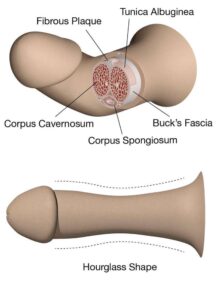Peyronie’s disease is characterised by the formation of plaques made of hardened scar tissue on the surface of the penis, affecting approximately 9% of middle-aged and elderly men.
The presence of plaques makes the penis rigid, so during erection, the whole penis expands except the area with plaque which causes contracture of penis and that forces it to bend in unnatural ways as can be seen below. This abnormal bending of the sexual organ can hinder proper blood flow and even make penetration impossible.

Moreover, the accumulated plaques can weaken the penile muscular tissue and reduce blood flow to the area, preventing an erection or cause the blood to leave the penis too rapidly, causing the premature loss of erection. However, the relationship between Peyronie’s disease and erectile dysfunction is complex and bilateral. Recent studies show that untreated erectile dysfunction can itself be a cause of Peyronie’s disease, not only a result of it. Seeking erectile dysfunction treatment can, in some cases, effectively prevent the development of Peyronie’s disease.
The O Concept™ was created by Dr. Wakil to offer a wide range of non-surgical treatments for sexual dysfunction, and is now available as a UK treatment for Peyronie’s disease.
The O Concept™ is a bespoke program where the patient receives a Peyronie’s disease treatment protocol that is tailor-made especially for him and his specific condition in order to achieve the best results. The O Concept™ is the only treatment protocol that combines treatments in specific order and at precise intervals based on each individual patient and their specific condition.
Referred to as the Godfather of Sexual Aesthetics, Dr. Wakil has been awarded multiple national and global awards for his work in sexual rehabilitation and penis rejuvenation, treating over 25,000 cases worldwide.
Treatment cost
Price From* After consultation the doctor will confirm the cost.
Treatment Summary at a glance
Dependent on the number of treatments our doctors will recommend.
Every treatment protocol is tailored to each patient. The number of treatment sessions will vary accordingly.
Most of our procedures do not require anaesthesia, however, topical anaesthesia may be required dependent on the nature of the procedure.
How can we help you?
A 2017 survey by counselling organisation Relate found that only a third (34%) of UK adults are satisfied with their sex lives, while 32% have experienced a sexual problem.
Dr. Sherif Wakil and his team of qualified health professionals have helped diagnose and treat thousands of patients worldwide with the groundbreaking multi-factorial O Concept™ protocol developed by Dr Wakil in early 2013.
The patient receives a tailored-made treatment protocol for Peyronie’s disease made unique for him and him specific condition. In order to achieve the best results following the diagnosis based on a combination of clinical assessment, medical history, and patient-reported symptoms.
We offer interest FREE finance plans to patients. Please contact our experienced team to learn more.
FAQ's
There are primarily two main types of Peyronie’s disease:
- Stable Peyronie’s Disease: In this type, the condition has stabilized, meaning the curvature and other symptoms have remained relatively constant for at least three to six months. The stable phase indicates that the scar tissue has stopped progressing, and there is no further worsening of the curvature or other symptoms.
- Active or Acute Peyronie’s Disease: This type refers to the initial inflammatory phase of the condition when the scar tissue is actively forming and progressing. During this phase, individuals may experience increasing pain, penile curvature, and other symptoms. It is important to seek medical attention during this active phase to assess the severity of the condition and explore potential acute Peyronie’s disease treatment options.
The exact cause of Peyronie’s disease is not fully understood. However, several factors are believed to contribute to its development. Some common causes and factors associated with Peyronie’s disease include:
- Trauma or Injury: Injury or trauma to the penis, such as during sexual activity or other forms of penile trauma, is considered a significant risk factor. It is believed that repetitive or acute trauma to the penis can lead to the formation of scar tissue.
- Genetics: There may be a genetic predisposition to developing Peyronie’s disease. Some studies suggest that certain genes and family history may increase the likelihood of developing the condition.
- Connective Tissue Disorders: Peyronie’s disease has been observed in individuals with certain connective tissue disorders, such as Dupuytren’s contracture, which affects the hand. This suggests a potential link between the abnormalities in connective tissue metabolism and the development of scar tissue in the penis.
- Inflammation: Inflammation within the penis is believed to play a role in the development of Peyronie’s disease. It is thought that inflammation triggers an abnormal healing response, leading to the formation of fibrous scar tissue.
- Other Health Conditions: Certain medical conditions, such as diabetes, high blood pressure, and some autoimmune disorders, have been associated with an increased risk of Peyronie’s disease.
Some conventional treatments for Peyronie’s disease include:
- Observation: In cases where the symptoms of Peyronie’s disease are mild and do not significantly affect sexual function or quality of life, a “watchful waiting” approach may be recommended. This involves monitoring the condition over time to assess if it stabilises or improves on its own without intervention.
- Medications: Several medications may be prescribed to help manage Peyronie’s disease, although none can completely reverse the condition. These medications include oral medications such as vitamin E, pentoxifylline, and colchicine, which may be prescribed to reduce pain, inflammation, and plaque formation.
- Injections: Injecting medications directly into the plaque or scar tissue, such as collagenase (Xiaflex), can help break down the scar tissue and improve penile curvature.
- Physical Therapy and Traction Devices: Certain physical therapy techniques, such as penile traction therapy, may be used to help reduce penile curvature and stretch the scar tissue. These techniques involve applying gentle, controlled tension to the penis using specialised devices or devices prescribed by a healthcare professional.
- Surgical Procedures: Surgery may be considered in severe cases of Peyronie’s disease that significantly impact sexual function or cause severe penile curvature. Surgical options include: a. Penile plication: This procedure involves suturing the unaffected side of the penis to reduce curvature and straighten the penis. b. Excision and grafting: In this procedure, the plaque or scar tissue is surgically removed, and a graft is placed to replace the removed tissue. This can help straighten the penis but may result in some loss of length.
- Penile prosthesis implantation: In cases where Peyronie’s disease coexists with severe erectile dysfunction, the placement of a penile prosthesis may be considered to restore sexual function and correct penile curvature.
The O Concept™ protocol founded by Dr. Wakil uses the latest cutting-edge non-surgical treatments that could achieve similar surgical results, in just a few sessions, approx. 20-40 mins each, with no to very little down-time, and no side effects reported.
Testimonials
Dr SW Clinics






